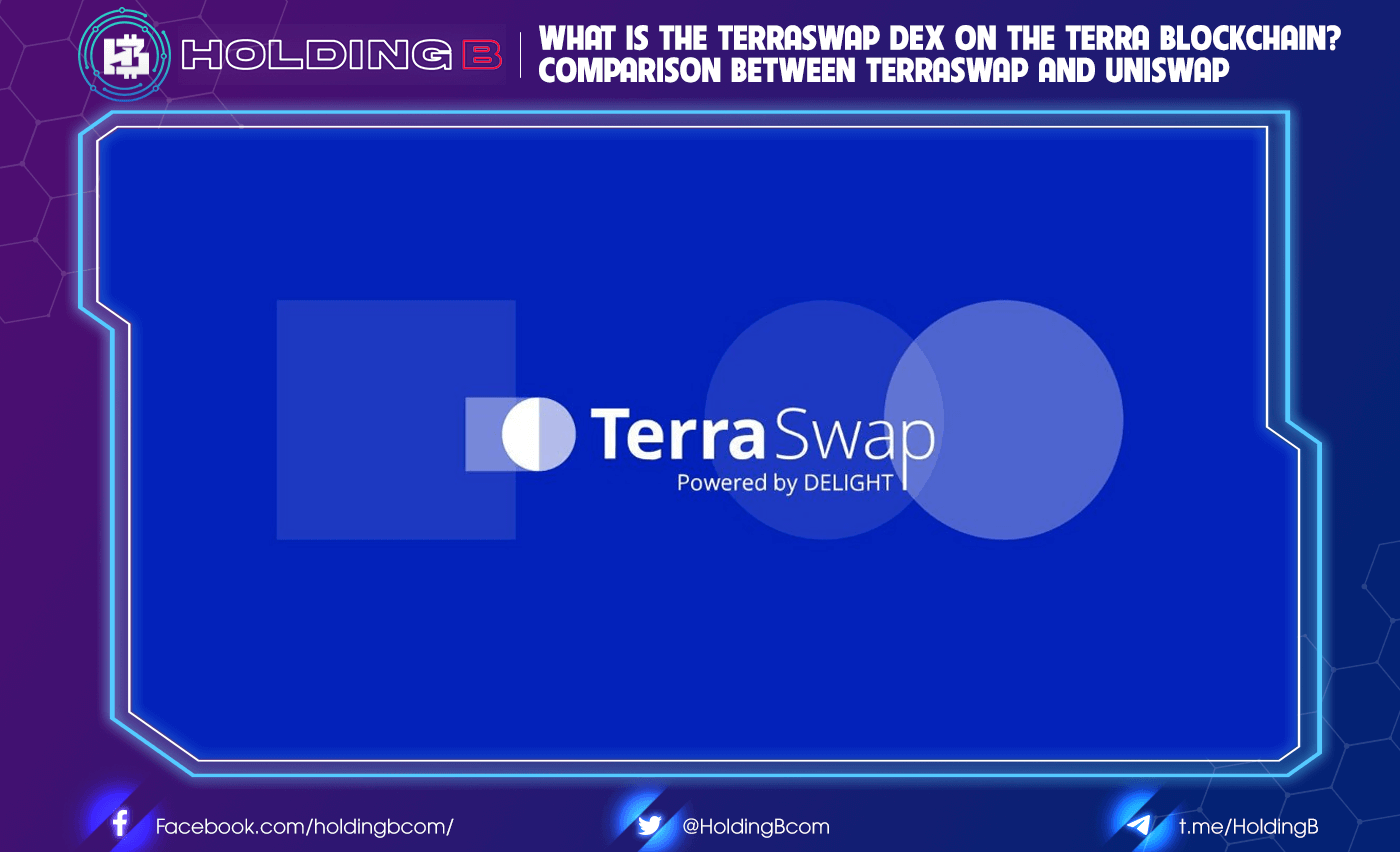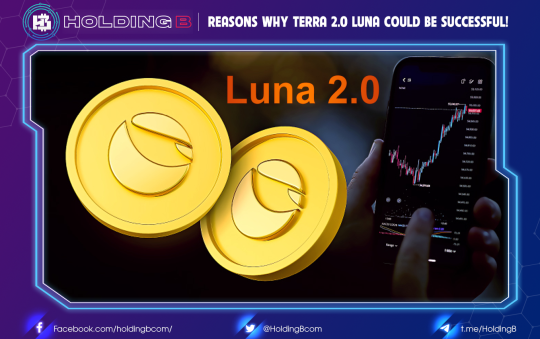Overview of Terraswap
Terraswap is an automated market-making protocol (AMM) inspired by Uniswap deployed with smart contracts on the Terra blockchain. This enables decentralized on-chain exchange for various assets associated with the Terra ecosystem.

Terraswap users can become traders, liquidity providers, or both. In there:
- A trader can exchange their token for another via Terraswap using the price determined by the liquidity pool ratio.
- The liquidity provider adds the equal value of the two assets to their respective Terraswap pair pool. This helps to increase the liquidity of the respective pairs market while maintaining the group price. In the process, liquidity providers are rewarded with newly generated LP tokens. The LP token represents the liquidity provider’s share in the pool and provides the benefit of earning transaction fees, which are accrued to the pool on each swap. Liquidity providers can burn their LP tokens to withdraw their shares from the pool.

According to statistical data from DefiLlama, up to now, Terraswap is the DEX with the largest TVL volume on the Terra network. At one point, TVL on Terra reached more than $2.2 billion, many times higher than the level at the beginning of 2021 (about more than $50 million).
How it works on Terraswap?
Terraswap works on the following key mechanisms:
- Liquidity pools: Terraswap creates automated markets for token pairs (or Terra UST stablecoins) called pools that allow users to exchange one asset for the other directly on-chain. The liquidity pool maintains balances of both assets, which users can provide liquidity in exchange for LP tokens. Basically, this form is similar to other DEX exchanges like Uniswap or QuickSwap…
- Constant Product: Pools on Terraswap create prices based on a constant, immutable product. The product of the number of tokens on each side of the pool must be constant during trading (buy/sell) operations.
- Pricing Mechanism: To keep the product constant, Terraswap will offer prices that ensure the product has the resulting pool balance as close to the pre-computed product as possible.
Transaction fee
Each liquidity pool for the asset pair whitelisted has an LP commission rate paid as a trading fee in addition to the spread determined by algorithmically pricing. In Terraswap, the LP commission is fixed at 0.3% and is paid from the trader’s assets received from trades executed.
Additionally, if the asset being traded is a native token like UST, the Terra network will be subject to a transfer tax (which is not controlled by the Terraswap contract).
The LP commission paid in each trade goes back to the respective liquidity pool as a fee to the liquidity providers. The LP commissions accrued to the pool can be withdrawn by burning the LP tokens generated from the liquidity provision.
Compare AMM DEX on Ethereum and Terra (Uniswap and Terraswap)
First thing,DEX is a decentralized exchange that allows users to easily interact and trade between crypto assets and provides liquidity to earn fees. Everyone knows uniswap famous as the first DEX ever. Terraswap is also the largest DEX to date on the Terra blockchain. To help you better understand Terraswap, in this section we will briefly compare both these DEXs based on some statistics below.
1. Uniswap TVL vs Terraswap
For ease of visualization, we will only calculate TVL for Uniswap v3 and Terraswap. The TVL gap between Uniswap and Terraswap started widening since August as more and more liquidity became available on Uniswap. Terraswap’s TVL currently accounts for 8% of Uniswap but both show an increasing trend in TVL. A DEX should have a growing TVL to easily convert one asset to another without slipping higher.
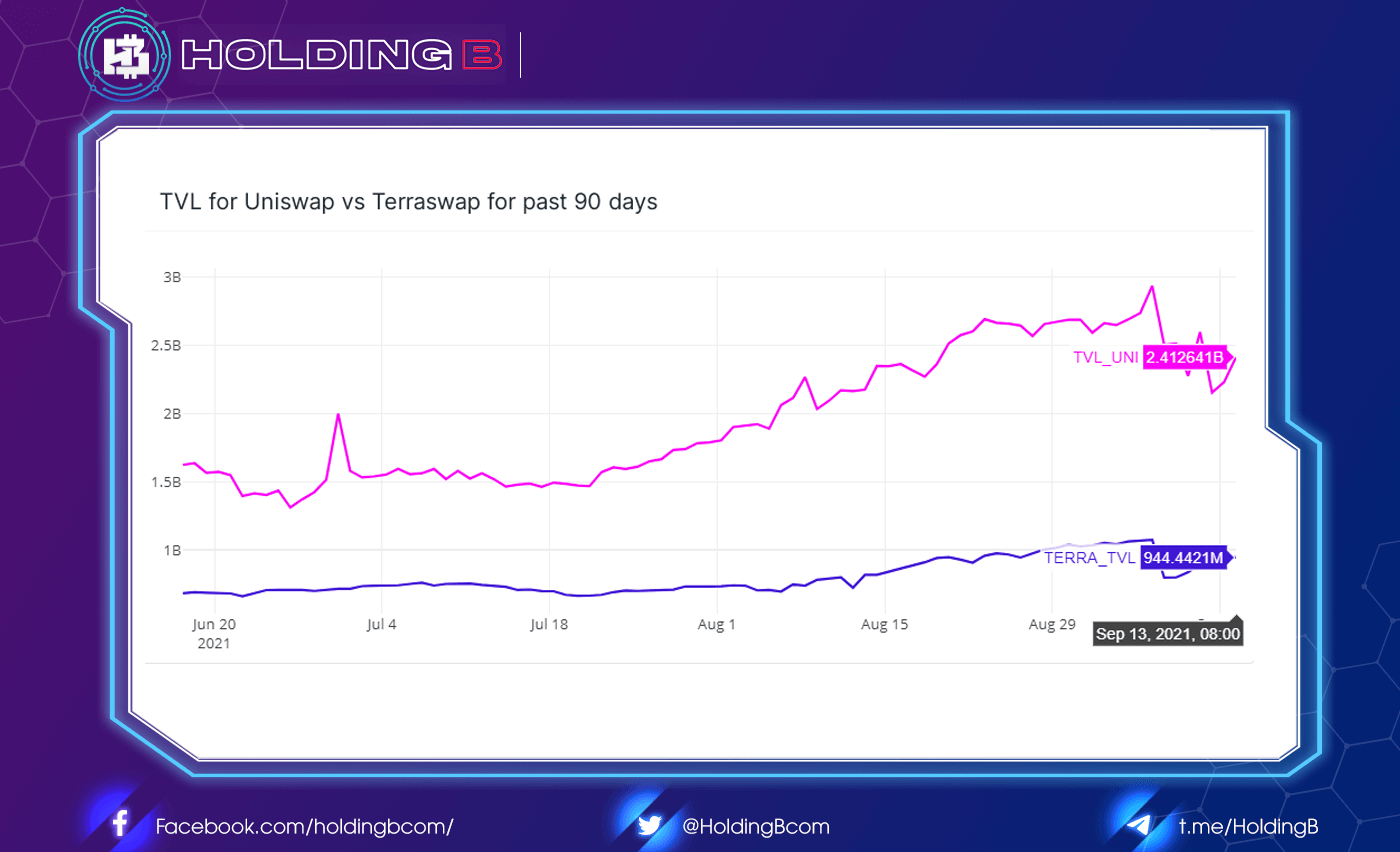
However, watch TVL across all ecosystems. Ethereum is currently at the top with $129 billion while Terra has just $7 billion. Compared to DEX, Terraswap accounts for 1/7 of the total TVLs across the Terra ecosystem while Uniswap is only 1/64 of the total TVLs of the entire network. This could be a good thing for Terra as more liquidity is concentrated in the largest DEX and not diversified into any other DEX like on Ethereum.

However, in the future as more and more protocols are introduced on Terra, there is no guarantee this unique position will still hold. There will probably be a lot of new AMM DEXs popping up and trying to compete for liquidity on Terra.
However, currently Terraswap does not or does not have any associated tokens. This is an opportunity for other AMM DEXs to introduce governance tokens to boost their liquidity. If this scenario happens, it is likely that Terraswap will launch its own token in the near future. And most likely there will be an airdrop similar to Uniswap.
2. LP on Uniswap vs Terraswap
Next, we’ll look at the added daily liquidity on both of these DEXs. The reason why Uniswap’s TVL isn’t shown as top is because of their LP. Uniswap LPs are more active in adding and withdrawing liquidity to look for opportunities for others.
Unlike Uniswap, Terraswap LPs tend to be more passive in providing liquidity. From the amount of added liquidity, we can see that most LPs on Uniswap are “whales” and LPs on Terraswap are usually retail investors. The added daily liquidity on Uniswap has gone up to 1.5 to 2 billion USD a day, while the maximum for Terraswap is less than 50 million USD.

Next, we will calculate and count the number of unique users providing liquidity on Uniswap and Terraswap. The drop in unique user offers on Uniswap also contributes to the low TVL ratio of Uniswap across the entire Ethereum blockchain. On the other hand, we can see the number of unique users on Terraswap growing.
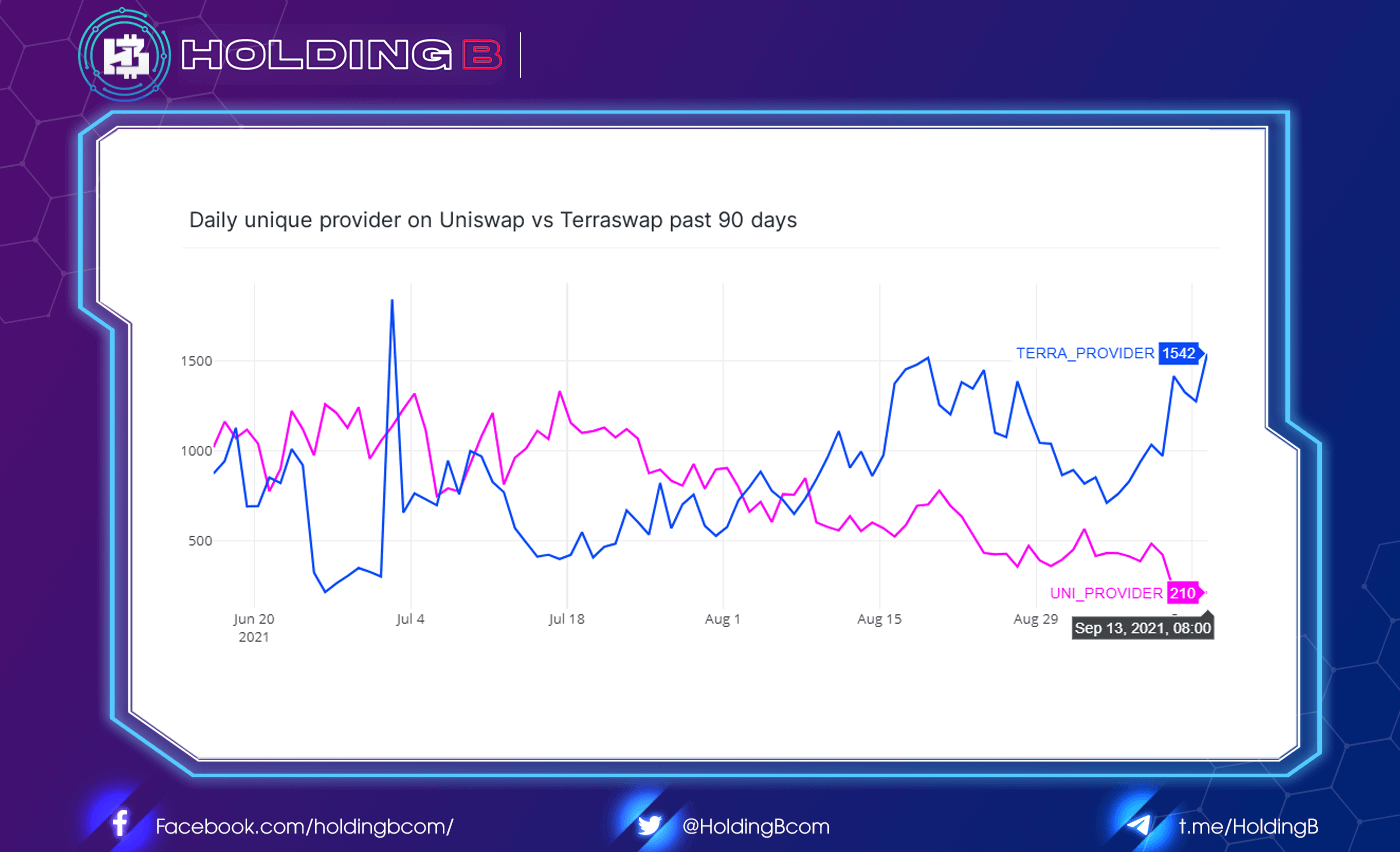
This is encouraging as more and more users join Terra, this is likely due to the update of Col-5. However, the volume of liquidity offered on Uniswap is too large compared to Terraswap with LPs providing less liquidity. With this inverse graph of unique LPs on Uniswap and Terraswap, we can predict whales from Ethereum will bridge and provide liquidity on Terra.
3. Swap rate statistics on Uniswap vs Terraswap
Finally, we compare the swap statistics between Uniswap and Terraswap. Although Uniswap’s TVL ratio is low compared to the entire Ethereum blockchain, it has active and consistent transactions and swaps. Daily volume via Uniswap is almost 100 times that of Terraswap.
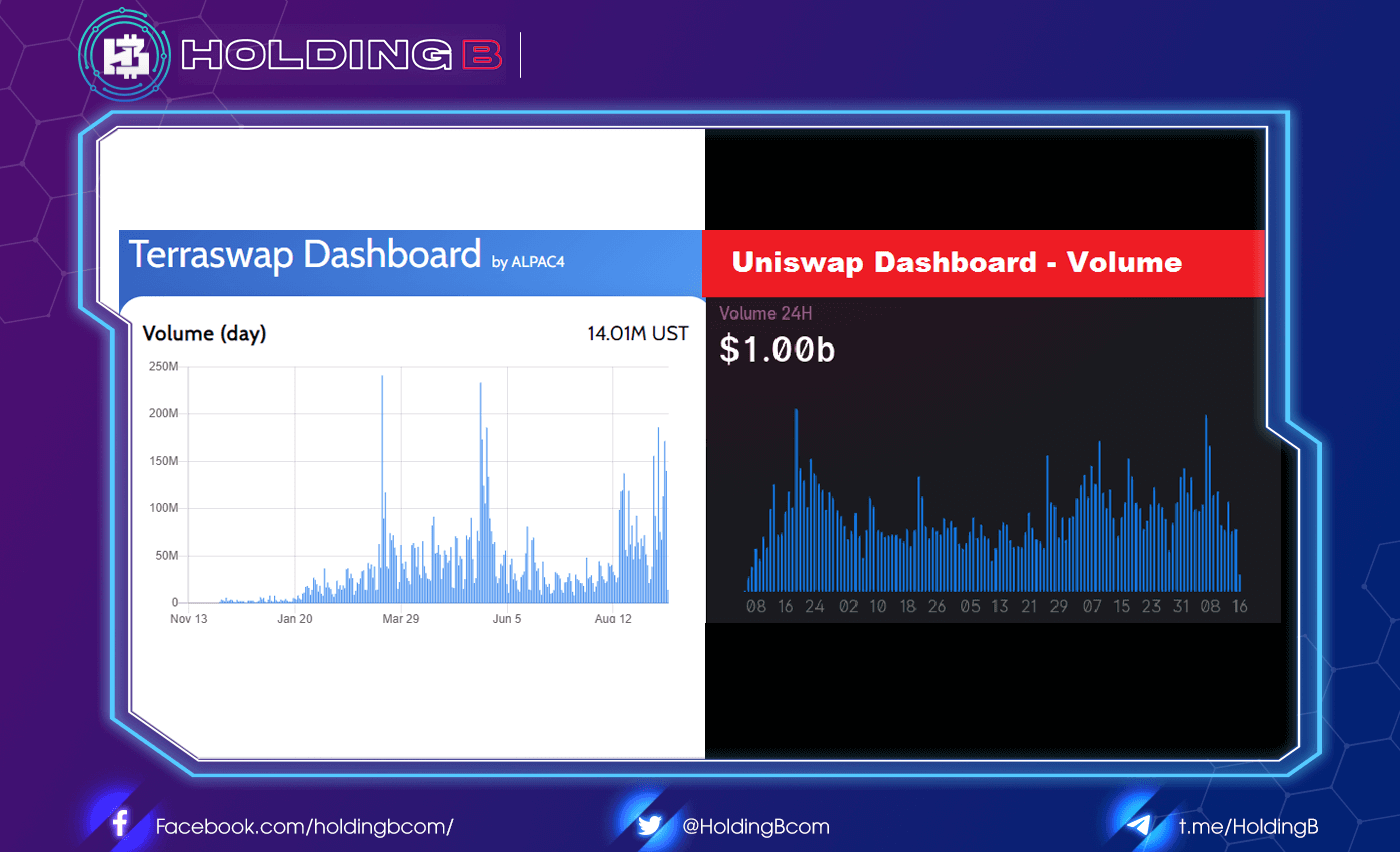
This is also why whales like to stake all their tokens for liquidity. A DEX with fewer transactions will fail and discourage LPs from providing the necessary tokens for them to suffer. However, both DEXs still have consistent daily swaps. are active daily and include swaps.
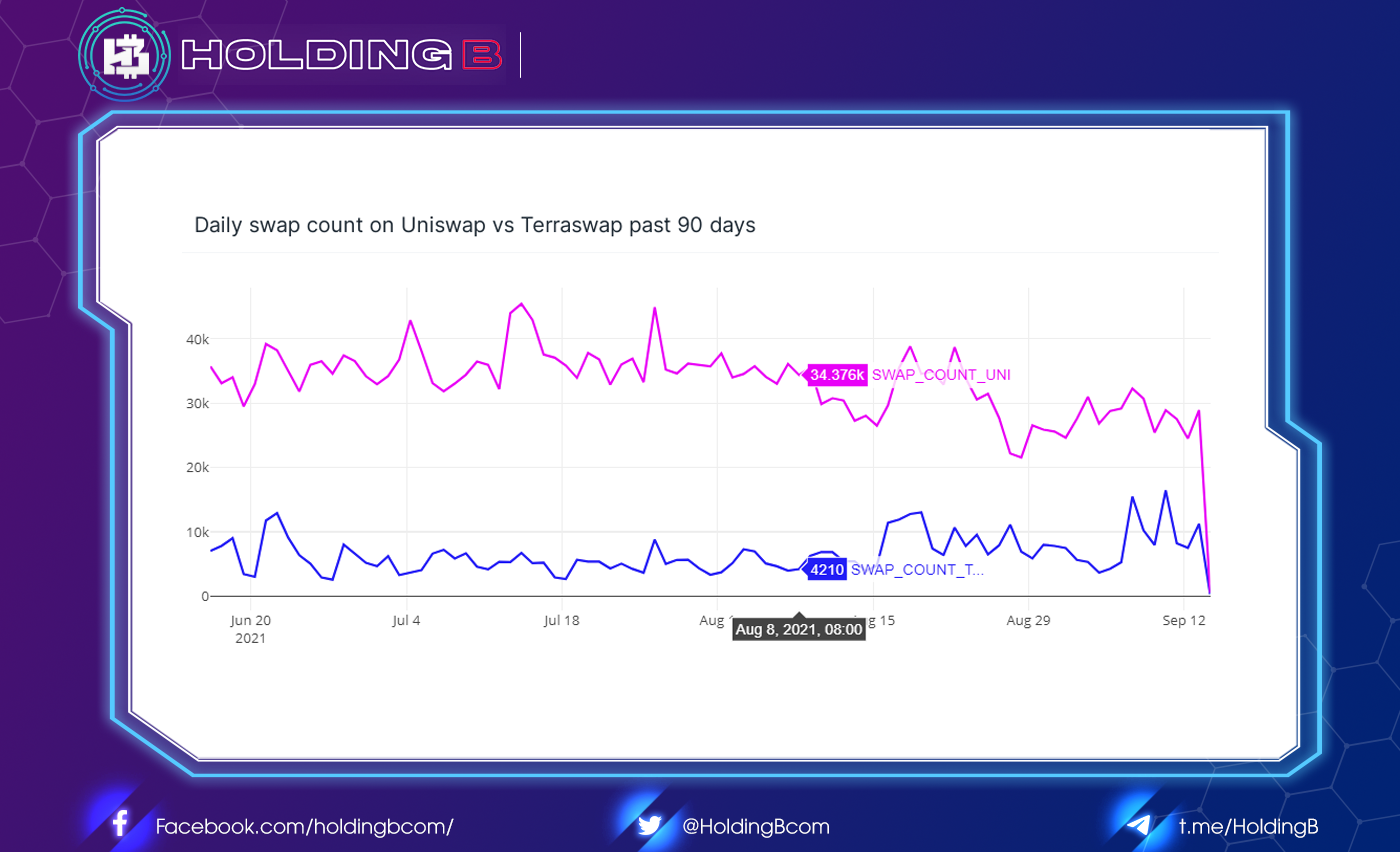
We will also need to calculate the number of daily unique traders across Uniswap and Terraswap. The number of traders on Uniswap is almost 4 to 8 times higher than that of Terraswap. From the previous chart of the number of unique LPs, we see that Uniswap’s trader/LP ratio is around 200 unique traders per LP. This number on Terraswap is only about 2.
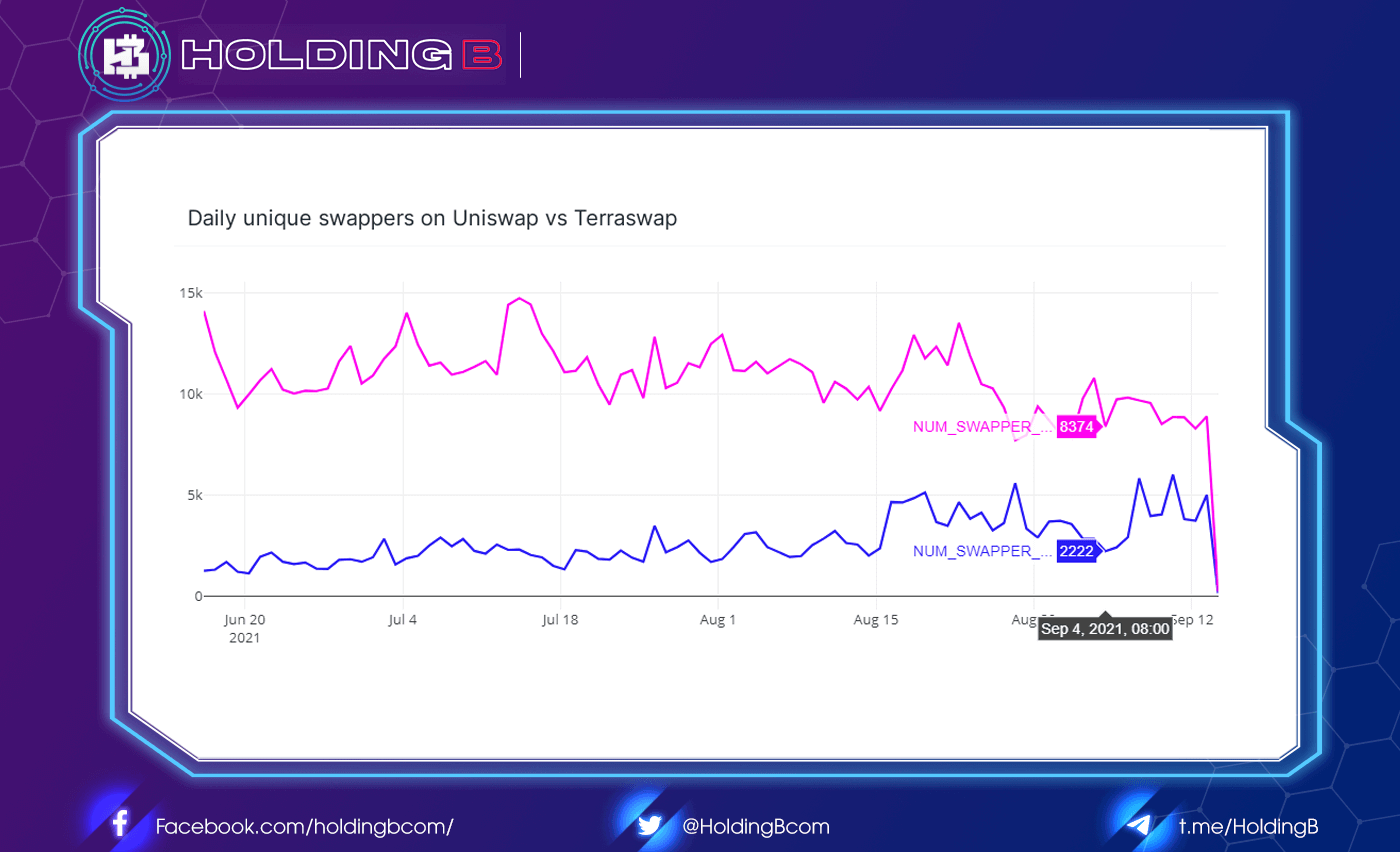
The rate on Uniswap is rated as good while on Terraswap is somewhat riskier. With such a low number of traders and LPs, higher slippage will occur and lower fees will be generated. And this low fee will eventually convince LPs that provide liquidity on other DEXs with higher and matching fees to be created. However, users on Terraswap tend to stay with Terra and make Terraswap TVL comparable to Uniswap.
Conclusion
In summary, Terraswap as the most active AMM DEX on Terra is showing progress and will evolve into another state. It has a TVL equivalent to Uniswap and has more liquidity providers than Uniswap. Things to improve for Terraswap are the number of traders and daily active users. And that is also the reason why we can see all the exchanges out there that are giving many promotions to attract traders to come and make trades on the exchange.
See ya in the next article !
Don’t forget to follow useful articles about Crypto Market from team Holding B !!!
- Telegram Channel: https://t.me/HoldingBcom
- Telegram Group: https://t.me/HoldingB
- Website: https://holdingb.com/
- Twitter: https://twitter.com/HoldingBcom
- Facebook: https://www.facebook.com/holdingbcom

